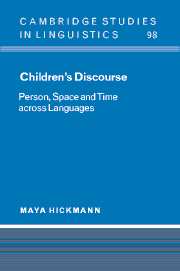Book contents
- Frontmatter
- Contents
- List of figures
- List of tables
- Preface
- List of abbreviations and conventions
- 1 Introduction
- Part I AVAILABLE THEORIES AND DATA
- 2 Theoretical issues
- 3 Cross-linguistic invariants and variations
- 4 Coherence and cohesion in discourse development
- 5 Children's marking of information status: referring expressions and clause structure
- 6 The acquisition of spatial and temporal-aspectual devices
- Part II A CROSS-LINGUISTIC STUDY OF CHILDREN'S NARRATIVES
- Appendix
- Notes
- References
- Author index
- Subject index
6 - The acquisition of spatial and temporal-aspectual devices
from Part I - AVAILABLE THEORIES AND DATA
Published online by Cambridge University Press: 22 September 2009
- Frontmatter
- Contents
- List of figures
- List of tables
- Preface
- List of abbreviations and conventions
- 1 Introduction
- Part I AVAILABLE THEORIES AND DATA
- 2 Theoretical issues
- 3 Cross-linguistic invariants and variations
- 4 Coherence and cohesion in discourse development
- 5 Children's marking of information status: referring expressions and clause structure
- 6 The acquisition of spatial and temporal-aspectual devices
- Part II A CROSS-LINGUISTIC STUDY OF CHILDREN'S NARRATIVES
- Appendix
- Notes
- References
- Author index
- Subject index
Summary
We now turn to the available developmental research concerning children's acquisition of spatial and temporal-aspectual devices. With respect to spatial devices (Section 6.1), a large number of studies have invoked general (cognitive, perceptual) factors to account for recurrent developmental sequences, but recent results show that language-specific factors also affect the rate and course of development. Less is known about pragmatic determinants of acquisition in this domain, although some evidence shows that young children have difficulties anchoring spatial information and that typological factors affect how they select and organise it in discourse. With respect to temporal-aspectual devices (Section 6.2), much of the available research has focused on the cognitive determinants of the acquisition of tense-aspect morphology and connectives. A large body of studies have supported the hypothesis that children's uses of verbal inflections are determined by universal concepts of situations and that they initially mark aspect, but not tense. This claim, however, has not remained uncontroversial in the light of two types of evidence: cross-linguistic evidence suggesting that it should be strongly modified and evidence for discourse pragmatic determinants that are not taken into account by the hypothesis. It is concluded (Section 6.3) that more cross-linguistic research is necessary to determine the relative impact of semantic, discourse functional, and language-specific factors on acquisition in these domains.
Motion and location
Studies stemming from different traditions and disciplines are relevant to address current controversial questions concerning the relation among different (perceptual, motor, cognitive, linguistic) components of spatial cognition during ontogenesis.
- Type
- Chapter
- Information
- Children's DiscoursePerson, Space and Time across Languages, pp. 141 - 172Publisher: Cambridge University PressPrint publication year: 2002



